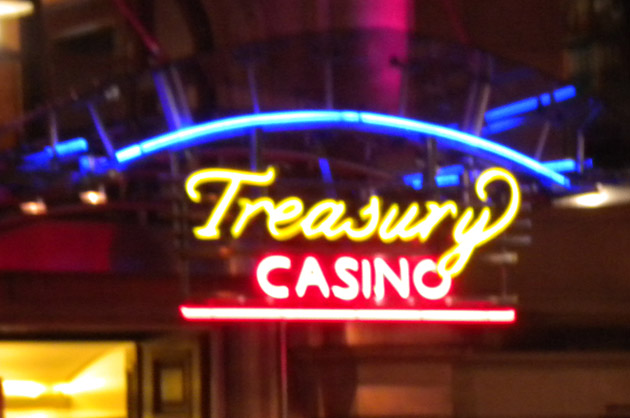 Tabcorp Group in Australia operates a range of hotels and complexes, including four casinos: Star City in Sydney; Conrad Jupiters on the Gold Coast, Conrad Treasury in brisbane; and Jupiters Townsville. They reported a 2009 profit after tax of $522 million.
Tabcorp Group in Australia operates a range of hotels and complexes, including four casinos: Star City in Sydney; Conrad Jupiters on the Gold Coast, Conrad Treasury in brisbane; and Jupiters Townsville. They reported a 2009 profit after tax of $522 million.
Well done, and nothing wrong with that. Tabcorp is one of the world’s largest gambling companies.
It struck me that on its website, in the ‘about us’ section, the very first sentence starts, ‘Tabcorp is a successful, diversified and responsible organisation…’
I fear that the company over-emphases its word ‘responsible’. A crude search on its site shows that the word appears 66 times. A search for the word ‘leadership’ returns 24 hits, as does the word ‘profit’.
So, with a fixation on the word ‘responsible’ and a statement in the section about ‘Integrity’ saying, ‘We take our obligations seriously – not paying lip service to compliance’, I was keen to understand what the company meant when it said (in its brochures called ‘Responsible gambling’ which it places throughout its properties and next to all ATMs), ‘The odds of winning are incorporated in all of our gaming Guides.’
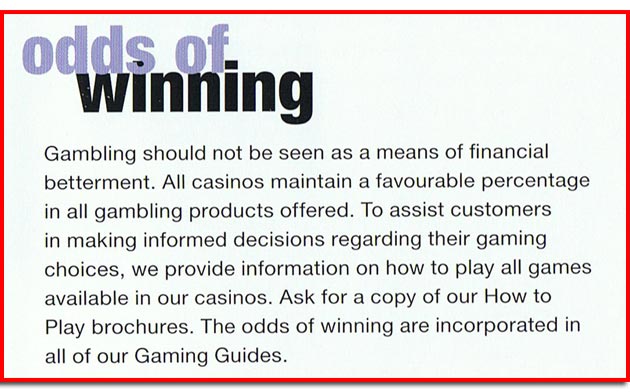 Incidentally, the brochures also stated something fundamentally true, and which all gamblers would do well to understand: ‘Gambling should not be seen as a means of financial betterment. All casinos maintain a favourable percentage in all gambling products offered.’
Incidentally, the brochures also stated something fundamentally true, and which all gamblers would do well to understand: ‘Gambling should not be seen as a means of financial betterment. All casinos maintain a favourable percentage in all gambling products offered.’
However, although gambling addiction is a super-mega-complex problem, and one that manifests differently for each person, one of the problems in my opinion has been the ignorance of gamblers. They simply do not understand the laws of probability. Their mathematical skills are abysmal. Many of the problem gamblers whom I happen to know are talented in some areas of their life, and completely ignorant when it comes to the odds of winning.
Therefore, it piqued my interest to read that Tabcorp incorporates the odds of winning in all its gaming Guides. And for this reason, I visited two of its four casinos and obtained a copy of each of the gaming guides to see if the odds of winning are made clear to patrons and gamblers. So let’s review these here.
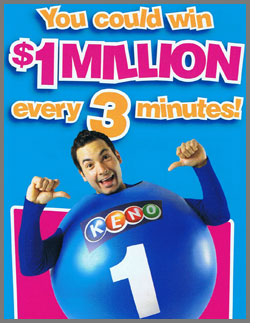 The Keno brochure is the only one that came close to making any sense. It stated, ‘Your chance to win the 10 Number Jackpot is 1 in 8,911,711…’ I wonder if players truly understood what this means. This is approximately the population of Queensland and Victoria, combined! Every woman, man, and child. So imagine this scenario: Give me one dollar, and you could win one million dollars, but you had to walk up to one person and tap them on the shoulder. You can pick any person you like. You have nine million to choose from. I would have combed the length and breadth of Queensland and Victoria, and gone into every school and every shopping centre and visited the young and old in every street in every suburb. And having visited every farm and every house and every pub and very hospital, I would have silently eyed out a person whom I would declare the winner. No one will know who I picked. And no one would know where I had travelled. On a piece of paper in my pocket is the person who I would have selected as being the star. All you have to do is roam the length and breadth of the entire two states in search of a person to tap on the shoulder. All you have to do is tap one person on the shoulder, and if it the person that I had chosen as the star, then you win a million dollars. Now tell me this: in your wildest dreams, do you think that you can travel the highways and the byways of these two vast states and pick one person who happened to be the very person that I had secretly selected? If a gambler can understand these odds, they will begin to understand that ‘gambling for fun’ is one thing, but gambling with an earnest desire to win, is really far fetched.
The Keno brochure is the only one that came close to making any sense. It stated, ‘Your chance to win the 10 Number Jackpot is 1 in 8,911,711…’ I wonder if players truly understood what this means. This is approximately the population of Queensland and Victoria, combined! Every woman, man, and child. So imagine this scenario: Give me one dollar, and you could win one million dollars, but you had to walk up to one person and tap them on the shoulder. You can pick any person you like. You have nine million to choose from. I would have combed the length and breadth of Queensland and Victoria, and gone into every school and every shopping centre and visited the young and old in every street in every suburb. And having visited every farm and every house and every pub and very hospital, I would have silently eyed out a person whom I would declare the winner. No one will know who I picked. And no one would know where I had travelled. On a piece of paper in my pocket is the person who I would have selected as being the star. All you have to do is roam the length and breadth of the entire two states in search of a person to tap on the shoulder. All you have to do is tap one person on the shoulder, and if it the person that I had chosen as the star, then you win a million dollars. Now tell me this: in your wildest dreams, do you think that you can travel the highways and the byways of these two vast states and pick one person who happened to be the very person that I had secretly selected? If a gambler can understand these odds, they will begin to understand that ‘gambling for fun’ is one thing, but gambling with an earnest desire to win, is really far fetched.
Indeed, each month, millions of dollars are handed out to Keno winners. Of course people win, at random, by pure chance, and yes, maybe one day you could be the lucky winner. But what they don’t tell you is how much was lost. The Keno website shows that for the month of September, $51,500,033 had been won. But how many people played? How much money did they spend. You can say, wow, $51 million was won, but how much was spent, by how many people, over how many games? And a true-blue gambler would say, I don’t care, I want to play because one day, I might win. But how many people shared in that $51 million. Was it ten people or a million people? And of all those people who shared this $51 million, how much had they sunk into the game over their lifetime before they won a prize large enough to satisfy their fantasy?
According to the Australian Bureau of Statistics (ABS), ‘The total net takings from gambling during 2004-05 was $15,459,700,000.’
For the same period, the ABS reported, ‘Revenue paid to government in gambling/gaming taxes and levies was $5,633,000,000.’
Interestingly, it said that ‘at the end of June 2005, there were 199,930 poker/gaming machines for which licences had been issued…’
It reported that ‘at the end of June 2005, there were 76,848 persons employed in the provision of gambling services.’
So, it’s all good for the economy. But let’s go back to the odds of winning. Would you give me one dollar, and go in search of one person in Queensland or Victoria whom I might have selected as the star person? If you can’t wrap your mind around the sheer quantity of nine million people, then think about it this way. The average notebook computer might have a screen resolution of 1024 x 768 pixels (picture elements). Come closer to your LCD computer screen (you might need a magnifying glass) and see if you can spot one pixel. This full stop ‘ . ‘ might well comprise four pixels. So split it into four. The whole screen would contain 786,432 pixels. So imagine 11 computers scattered around your room. I would have selected just one of the nine million pixels. Your job would be to just go and point to one of the pixels on any one of the 11 computers. What are your ‘chances’ of winning? This becomes a mathematic question. So let’s remove maths out of it and ask you, what is the likelihood of you winning?
Ok, you now understand the odds. And if you still wish to play Keno, that’s fine. But let’s look at how the casino meets its responsibility and helps its patrons to understand their odds of winning when playing other games.
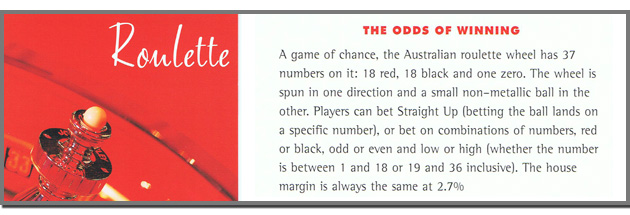 Here we are told that the house margin is always the same at 2.7%. Is it the responsible thing to do, to speak in terms that most people would not understand. If I were to go to the casino and select players at random, what are the chances of any of them telling me what is meant by this 2.7%? This brochure is designed to help patrons to learn how to play, and to advise them of their odds of winning. The brochure does an okay job at explaining the game, but how well does it meet its promise of being responsible? Is this really a sensible way of advising gamblers about their odds of winning?
Here we are told that the house margin is always the same at 2.7%. Is it the responsible thing to do, to speak in terms that most people would not understand. If I were to go to the casino and select players at random, what are the chances of any of them telling me what is meant by this 2.7%? This brochure is designed to help patrons to learn how to play, and to advise them of their odds of winning. The brochure does an okay job at explaining the game, but how well does it meet its promise of being responsible? Is this really a sensible way of advising gamblers about their odds of winning?
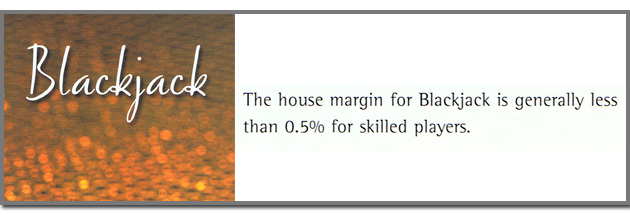 How does this help a player to understand the odds of winning? What is meant by, ‘The house margin for Blackjack is generally less than 0.5% for skilled players? How many gamblers can explain this? The brochure was printed to assist gamblers to understand their odds of winning. How many players are considered ‘skilled’. What does ‘generally’ mean? Here are the odd for some of the other games:
How does this help a player to understand the odds of winning? What is meant by, ‘The house margin for Blackjack is generally less than 0.5% for skilled players? How many gamblers can explain this? The brochure was printed to assist gamblers to understand their odds of winning. How many players are considered ‘skilled’. What does ‘generally’ mean? Here are the odd for some of the other games:
STUD POKER: ‘The house margin for Caribbean Stud Poker is about 5.5%, which includes and allowance for the jackpot.’
What does the word ‘about’ signify? And what does the allowance mean in relation to the gambler? Does 5.5% ‘include’ the allowance, or do they mean that it excludes some money (by taking it away from your side of the bargain) to fund a jackpot? Most unclear.
MINI BACCARAT: ‘The house margin for Mini Baccarat is approximately 1.2%.’
Now we see the word ‘approximately’. Is that an average, or really an approximation? In reality, it does not matter. The question is, how responsible is it to say that the casino complies with regulations and guidelines, when it does not really assist its gamblers to understand what hope they have of winning?
WHEEL: ‘The house margin is 7.7% for all symbols and cannot be reduced.’
Why emphasis that it cannot be reduced? Are the other games sometimes reduced? It’s just that this statement is not mentioned in relation to other games, so what can we assume. What is it emphasising?
MINI DICE: ‘The house margin for mini dice is 3.7% and cannot be changed.’
The Wheel’s margin cannot be reduced. Yet this cannot be changed? What’s the difference? Is there a difference? If not; why the sloppy language? If there is a difference, then why the sneaky language?
SIC BO: ‘House margins for each type of bet vary from 2.8% (big, small or combinations of two dice) to 16.2% for a specific triple. Sic Bo is a game of chance so there are no betting strategies to reduce these margins.’
Is Mini Dice not also a game of chance? If so, why is this statement not also made for Mini Dice?
TREASURY 21 / JUPITERS PONTOON (Spanish Blackjack): ‘The house margin for Treasury 21 is generally 1.25%.’
My goodness. Most people cannot comprehend what the point-2 in 1.2 means. Now we expect the patrons to understand what .25 means? Not on your life.
I find it bemusing that this game allows the player to purchase insurance. I wonder what innovative ideas might spring from this. Imagine an insurance company offering overall cover for gamblers, perhaps akin to travel insurance. For the life of me, I have never understood travel insurance. Hence, I have never taken any. I think I did once, and was let down badly by the fine print. Every now and then I read the policy when an airline offers it to me when making an on-line booking. I just cannot work out under which situation I can claim? The limitations and permutations and convolutions make my eyes glaze over.
THREE CARD POKER: ‘The house margin for Three Card Poker is about 2.01% for skilled players.’
What on earth is the significance of the 0.01% when the preceding word is ‘about’. If it is about 2.01% then surely it would be correct to say ‘about 2%’. Please!
MACHINES: The two casinos I visited, the Conrad Jupiters and Conrad Treasury together have 1300 gaming machines. Imagine the floor space. A machine that offers a prize if the player can receive 5 of the same kind of symbol (5 of a kind) is said to offer one chance in 9,765,625 of the 5-of-a-kind combination happening on a single play line. That’s the population of Sweden. Imagine if every human in Sweden had a personal phone. Their numbers start at 1. And someone’s number is 15, and someone’s number 12823, all the way up to 9,765,625. You have one shot at dialling a number; any number from one to 9,765,625, and if you are lucky, you will dial the one chosen person in Sweden who can take your call and say, ‘Yes, you have won’. Mind you, I am not sure what you win. The brochure does not tell us what we can win if we obtain 5-of-a-kind. So, knowing this about the phone numbers, what do you think your chances are of winning?
Incidentally, I wonder why these brochures are not translated into other languages? What are the demographics of patrons? Never mind their mathematics skills. Tell me about their English language skills. How many could read these brochures? For a multi-billion dollar industry that relies upon tourists and foreigners and the ethnic types, why is this information not in any other language?
Consumers waited decades before products were labelled properly. For a long time, consumers had no idea about the ingredients that were used to manufacture foodstuffs. The use-by date was a recent innovation. With gambling being a devastating social disease that rips families apart, is this the best we can do? By all means, if casinos wishes to argue with me, I would take my hat off to them. Just be sure to tell the government and the community where to go. In other words, don’t pander to regulations and guidelines with nothing more than lip service. If casinos don’t agree that they have a duty to society and a corporate social responsibility, then they are entitled to their opinion. But just stop publishing responsibility crap!



Comments are closed.